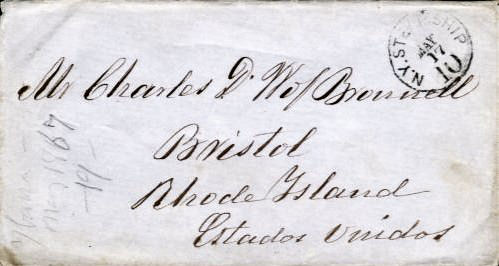![]()
Postal History Introduction
Stampless
Covers
1846
to 1900 Issues
1901-1950
Issues
1951-2003
Issues
Cancels
&
Miscellaneous
Postal
Stationery
Post
Cards
Air
Mail
First
Day &
Event Covers
Parcel Post/Special Delivery
Registered & Official Mail
Commercial & Advertising
Revenue & Postage Due
Wildlife & Game Issues
Complete List of RI Issues
|
Rhode Island Stampless
Covers & Letters |
|
|
|
|
"Steamship Mail" first appeared in 1849 and was in continuous use until 1875. This marking unlike the "SHIP" marking, which applied to mail entering the United states on "non-contract" ships, was carried via steamships that were under contract to the United States Post Office. The Steamship marking is considered an Origin Marking and was applied to identify these letters as distinct from ship mail. The routes sailed by the contract steamships were considered to be "Post Roads" by the postal service and included the Caribbean, Central and South America. (The address "Estados Unidos" clearly indicates that this letter was posted from one of those areas.) The initial steamship rates established in 1847 and in effect from 1848 to 1851 varied by port of origin. For example: Mail sent to and from Cuba was rated at 121/2 cents and mail from Chagres, Panama was rated at 20 cents. In 1851 Steamship rates were standardized at 10 cents for letters traveling less than 2500 miles and 20 cents for letters traveling over 2500 miles. The Postal Act of June 30, 1864, effective on July 1, 1864 created a single rate for all steamship mail regardless of the distance traveled. The rate was set at 10 cents and this continued until 1875 when the rate was reduced to 5 cents to conform to the Universal Postal Union (UPU) rate which applied to all mail sent and received from other countries. Steamship markings were discontinued when the UPU rates came into effect. The cover above is marked, "N.Y. STEAMSHIP MAY 17; 10." This marking was used on contract mail arriving at the port of New York from 1866 to 1874. The marking is in black and measures 23mm across the center. This marking is also known in red.
Recommended Reading for further
information: |

RI Historical
Society
Introduction
Stampless I
Stampless II
Stampless III
Stampless IV
Stampless V
Stampless VI
Brown & Ives Letters
The Hazard Family Letters
Joseph Tillinghast
Free Franked Letters
DeWolf Family Letters
Recently Added Pages
